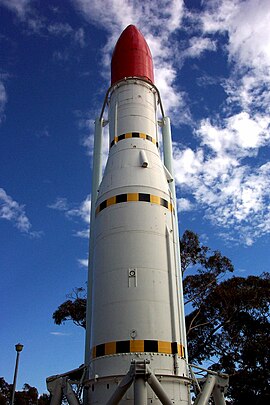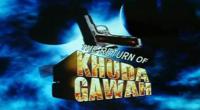 A mockup of the Black Arrow in the rocket park at Woomera. | |
| Function | Carrier rocket |
|---|---|
| Manufacturer |
Royal Aircraft Establishment Westland Aircraft |
| Country of origin | United Kingdom |
| Size | |
| Height | 13 metres (43 ft) |
| Diameter | 2 metres (6 ft 7 in) |
| Mass | 18,130 kilograms (39,970 lb) |
| Stages | 3 |
| Capacity | |
| Payload to 220 km LEO | 135 kilograms (298 lb) |
| Payload to 500 km LEO | 102 kilograms (225 lb) |
| Launch history | |
| Status | Retired |
| Launch sites | Woomera LA-5B |
| Total launches | 4 |
| Successes | 2 |
| Failures | 2 |
| First flight | 27 June 1969 |
| Last flight | 28 October 1971 |
| First stage | |
| Engines | Gamma 8 |
| Thrust | 256.4 kilonewtons (57,600 lbf) |
| Specific impulse | 265 seconds (2.60 km/s) |
| Burn time | 131 seconds |
| Fuel | RP-1/HTP |
| Second stage | |
| Engines | Gamma 2 |
| Thrust | 68.2 kilonewtons (15,300 lbf) |
| Specific impulse | 265 seconds (2.60 km/s) |
| Burn time | 116 seconds |
| Fuel | RP-1/HTP |
| Third stage – Waxwing | |
| Engines | 1 Solid |
| Thrust | 27.3 kilonewtons (6,100 lbf) |
| Specific impulse | 278 seconds (2.73 km/s) |
| Burn time | 55 seconds |
| Fuel | Solid |
Black Arrow, officially capitalised BLACK ARROW, was a British satellite carrier rocket. Developed during the 1960s, it was used for four launches between 1969 and 1971. Its final flight was the first and only successful orbital launch to be conducted by the United Kingdom, and placed the Prospero satellite into low Earth orbit.
Black Arrow originated from studies by the Royal Aircraft Establishment for carrier rockets based on the Black Knight rocket, with the project being authorised in 1964. It was initially developed by Saunders-Roe, and later Westland Aircraft as the result of a merger.
Black Arrow was a three-stage rocket, fuelled by RP-1 paraffin (kerosene) and high test peroxide, a diluted form of hydrogen peroxide (85% hydrogen peroxide + 15% water). It was retired after only four launches in favour of using American Scout rockets, which the Ministry of Defence calculated to be cheaper than maintaining the Black Arrow programme.
Contents
Development
Black Arrow originated from a Royal Aircraft Establishment proposal for a rocket capable of placing a 317-pound (144 kg) payload into low Earth orbit, in order to test systems designed for larger spacecraft. In the autumn of 1964, the programme was authorised by Conservative Aviation Minister Julian Amery. Then, following a general election in October, the incoming Labour government put the project on hold to reduce expenditure. Following another election, the government approved the continuation of the programme with several modifications, including the reduction of the test programme from five to three launches. The first launch was set for 1968.
Most of the technology and systems used on Black Arrow had already been developed or flight-proven on the Black Knight rocket, or the Blue Steel missile. Black Arrow was designed to reuse as much technology from the earlier programmes as possible in order to reduce costs, and simplify the development process. Many senior staff of the Black Knight programme transferred directly to Black Arrow, including the Chief Missile Scientist, Roy Dommett, the Chief Design Engineer, Ray Wheeler and the Deputy Chief Engineer, John Underwood.
Initial development was conducted by Saunders-Roe, which merged into Westland Aircraft in 1964. Westland was subsequently the prime contractor for the Black Arrow, and assembled the first and second stages at East Cowes on the Isle of Wight. Bristol Siddeley produced the first and second stage engines at a factory in Ansty, Warwickshire. The engines were test fired at the factory before being shipped to the Isle of Wight, where they were integrated into the rocket and the first stage engines were fired again at High Down. Bristol Aerojet produced the third stage in Somerset, while the Explosives Research and Development Establishment produced its solid propellant in Waltham Abbey, Essex. The Rocket Propulsion Establishment, based in Westcott, Buckinghamshire, was responsible for the design and integration of the stage.
The name Black Arrow came from the Ministry of Supply policy of assigning designations consisting of a colour and a noun, unofficially known as Rainbow Codes, to research programmes conducted by the Armed Forces.
Vehicle
The first and second stages of the Black Arrow were fuelled by RP-1 paraffin (kerosene), burnt using high test peroxide as an oxidiser. Due to the optimum mixture ratio being about 7, a larger oxidiser tank was required compared to many contemporary launch systems. The oxidiser tanks were located below the fuel tanks, following the practice of putting the more dense propellent at bottom in order to lower the centre of gravity and make the rocket easier to control. This arrangement had been pioneered by Germany and the United States, whereas the Soviet Union had placed oxidiser tanks above fuel tanks, making it easier for the lower tank to be filled first.
Thrust vectoring was used to provide attitude control on the first two stages. The eight first stage combustion chambers were arranged in pairs which could gimbal either way along one axis. Two of the pairs were arranged perpendicular to the other two, and when all four pairs were used together, they provided roll, pitch and yaw control. The second stage had two combustion chambers, which could gimbal along two axes, providing the same level of control. During a coast phase after second stage cut-off, the rocket was controlled by a reaction control system. The third stage did not have an attitude control system, and was instead spin-stabilised.
The first stage was powered by a single Gamma 8 engine, which burned for 127 seconds. The Gamma 8 was an eight-chamber engine, derived from the Gamma 301 engine used on the Black Knight. It was 6.9 metres (23 ft) long, and had a diameter of 2 metres (6 ft 7 in), the same diameter as the French Coralie. Coralie was used as the second stage of the Europa rocket, and the decision to give Black Arrow the same diameter as Coralie was taken in order to make it compatible with Blue Streak, which was used as the first stage of Europa. This would have allowed Black Arrow's payload capacity to have been increased, and would also have allowed Britain to use the first stage of Black Arrow as a backup to the Coralie. For this reason, all dimensions in the original specification were given in imperial units except the first stage diameter, which was given in metres.
The first and second stages were connected by an interstage structure containing four Siskin IB separation and ullage motors, which separated and ignited seven seconds after the first stage had cut off. The interstage separated from the second stage six seconds later. The second stage, which was 2.9 metres (9 ft 6 in) long and measured 1.37 metres (4 ft 6 in) in diameter, was powered by a two-chamber Gamma 2 engine which ignited shortly after the separation motors, and continued to burn for 123 seconds. Three minutes after launch, during the second stage burn, the payload fairing separated.
About 257 seconds into the flight, the second stage cut off, and the rocket entered a coast phase to apogee.[2] Immediately after cut-off, the second stage attitude control system was pressurised. During the coast the correct orientation for third stage separation was maintained by means of the attitude control system.[2] Towards the end of the coast period, the third stage was spun up to a rate of 3 hertz (180 rpm) by means of six Imp rockets.[2] Five seconds later, the third stage separated,[4] and following ten more seconds of coasting, it ignited. The third stage was a Waxwing solid rocket motor, which burned for 55 seconds.[2]
Just over a minute after the third stage had burned out, the payload was released, and gas generators were used to push the spacecraft and spent upper stage apart.[2] The delay between burnout and separation was intended to reduce the risk of recontact between the upper stage and payload due to residual thrust. Despite this, following spacecraft separation on the R3 launch, the upper stage collided with the Prospero satellite,[2] damaging one of the spacecraft's communications antennae;[16] however the spacecraft was still able to successfully complete its mission.[16] On the R3 launch, the ascent took 710 seconds (11.8 min) from liftoff to spacecraft separation.[2]
Although none were ever built, several derivatives of Black Arrow were also proposed, as ways of increasing its payload capacity.[2] One proposal added eight Raven solid rocket motors from the Skylark programme to the first stage as booster rockets.[4] Another suggestion was to mount the entire rocket atop a Blue Streak missile,[2] while a third proposal involved replacing the Gamma engines with the more powerful Larch.[4]
Launches
Four Black Arrows were launched between 1969 and 1971. The first two launches were demonstration flights, with battleship third stages and a boilerplate payload. On the first flight an electrical fault caused a pair of first stage combustion chambers to pivot back and forth.[17] Before it cleared the launch pad, the rocket was rolling erratically, and about a minute later it began to disintegrate. After the first stage engine failed, and the rocket began to fall back to earth, it was destroyed by range safety.[18] The second launch was successful. The first all-up launch on 2 September 1970 was the third launch of the Black Arrow, and Britain's first attempt to launch a satellite. The launch failed due to a leak in the second stage oxidiser pressurisation system, which caused it to cut out early. The third stage fired, but the rocket did not reach orbit, and re-entered over the Gulf of Carpentaria.[19] The fourth launch successfully orbited the Prospero (before the R2 mission, it was named Puck) satellite, making the United Kingdom the sixth nation to place a satellite into orbit by means of an indigenously developed carrier rocket. The satellite, also known as X-3, was named Prospero after the character Prospero in Shakespeare's The Tempest. The name was chosen as a reference to events in the play, in which Prospero, a sorcerer, gives up his powers.[20] Pr
Watch movie Black Arrow online on Amazon
Watch movie Black Arrow online
Watch The Movie On PrimeVachanam Full HD Movie Download

A Wednesday Full HD Movie Download

Badhaai Ho Badhaai Full HD Movie Download

Saaz Full HD Movie Download

Hattrick Full HD Movie Download

Dr Vidya Full HD Movie Download

Qaid Full HD Movie Download

Do Kaliyan Full HD Movie Download

Gunahon Ka Faisla Full HD Movie Download

Body Parts Full HD Movie Download

Rakshak: The Protector Full HD Movie Download

Eradane Maduve Full HD Movie Download

Gadvasu Pindam Full HD Movie Download

Patnam Vachina Pativratalu Full HD Movie Download

Sravana Sandhya Full HD Movie Download

Sati Sukanya Full HD Movie Download

Return Of Khuda Gawah Full HD Movie Download

Decoys Full HD Movie Download

Rowdilaku Rowdilu Full HD Movie Download

Ayaash Full HD Movie Download

Dhoom Full HD Movie Download

Download latest Movie from bollywood
- 1> baaghi 3
- 2> THE SKY IS PINK MOVIE FULL STORY AND REVIEW
- 3> Luka Chuppi
- 4> TO ALL THE BOYS I’VE LOVED BEFORE
- 5> Kabir Singh
- 6> Street Dancer 3D
- 7> Simmba
- 8> Gone Girl
- 9> The Girl Who Lived
- 10> Ludo
- 11> DILWALE DULHANIA LE JAYENGE
- 12> GUILTY
- 13> The Godfather
- 14> Adventures of Rusty
- 15> Sooryavanshi
- 16> Satyameva Jayate 2
- 17> Thappad
- 18> Bhool Bhulaiyaa 2
- 19> KGFChapter 2
- 20> Mardaani 2
- 21> Pinjar
- 22> Shivaji maharaj
- 23> Ek Villian 2
- 24> Hungama 2
- 25> Divergent
- 26> Mumbai Saga
- 27> The Internship
- 28> HIT (telugu)
- 29> Panga
- 30> The perfect date
- 31> 16 December
- 32> Gopala Gopala (Telugu)
- 33> Brahmastra
- 34> Gangubai Kathiawadi
- 35> Manmadhudu
- 36> Nenu local
- 37> Mahanati
- 38> Shatamanam bavathi
- 39> Lagaan
- 40> After
- 41> MOM
- 42> Shamshera
- 43> Raguvaran BTech
- 44> Khakee
- 45> The villain
- 46> OM
- 47> Mr. perfect
- 48> Bueatifull mind
- 49> Hichki
- 50> Gabbar Singh
- 51> Jogi
- 52> Before Sunrise
- 53> Before Sunset
- 54> Before Midnight
- 55> The Big Bull
- 56> Top Gun: Maverick
- 57> The Purge
- 58> The Sky is Pink
- 59> Laxmmi Bomb
- 60> Sadak 2
- 61> Sufna
- 62> Prithviraj
- 63> PK
- 64> Coolie No 1(2020)
- 65> Black Widow
- 66> Dear Zindagi
- 67> Dil Bechara
- 68> PHIR HERA PHERI
- 69> WAR
- 70> Dostana
- 71> RRR: Roudram Ranam Rudhiram
- 72> Maidan
- 73> Dabbang 3
- 74> Chhalaang
- 75> life as we know it
- 76> SherShaah
- 77> Sandeep Aur Pinky Faraar
- 78> Event Horizon
- 79> 83
- 80> Radhe: Your Most Wanted Bhai
- 81> Gunjan Saxena: The Kargil Girl
- 82> Mr India
- 83> Vivah
- 84> Anokha Bandhan
- 85> Ghost
- 86> Bhoot: Part One - The Haunted Ship
- 87> Haseen Dilruba
- 88> Laal Singh Chaddha
- 89> Qismat
- 90> Rajput
- 91> Drive
- 92> Dil Chahta Hai
- 93> Dil Ki Baazi
- 94> Dil Ka Rishta
- 95> Teesri Manzil
- 96> Dil
- 97> Love Aaj Kal
- 98> Khaali Peeli
- 99> Bunty Aur Babli 2
- 100> Atrangi Re
- 101> Gulabo Sitabo
- 102> Jodi
- 103> Suraj Pe Mangal Bhari
- 104> Deewana
- 105> Attack
- 106> Sardar Udham Singh
- 107> Toofan
- 108> THE LOVEBIRDS
- 109> Jersey
- 110> Ginny Weds Sunny
- 111> Thalaivi
- 112> Shiddat
- 113> Angels vs Zombies
- 114> Koi Mil Gya
- 115> Thank God
- 116> Bhuj: The Pride of India
- 117> Hum Aapke Hain Kaun
- 118> The Platform
- 119> Bird Box
- 120> Roohi Afzana
- 121> Torbaaz
- 122> Nikamma
- 123> World War Z
- 124> Extraction
- 125> Train to Busan
- 126> Life of Pi
- 127> SHAADI MEIN JROOR AANA
- 128> Himmat Aur Mehnat
- 129> To All The Boys: P.S. I Still Love You
- 130> Mimi
- 131> Good Newwz
- 132> Shubh Mangal Zyada Saavdhan
- 133> Raabta
- 134> Harry Potter and the Philosopher's Stone
- 135> Harry Potter and the Chamber of Secrets
- 136> Chhapaak
- 137> War of the Worlds
- 138> Harry Potter and the Prisoner of Azkaban
- 139> Harry Potter and the Goblet of Fire
- 140> MURDER MYSTERY
- 141> Shakuntala Devi
- 142> Bachchan Pandey
- 143> Jayeshbhai Jordar
- 144> Sheer Qorma
- 145> Saina
- 146> 'O' Pushpa I hate tears
- 147> Kedarnath
- 148> MS Dhoni The Untold Story
- 149> Chhichhore
- 150> Badhaai Ho
- 151> Unstoppable
- 152> Oz the Great And Powerful
- 153> The Girl on the Train
- 154> Haathi Mere Saathi 2020
- 155> The Conjuring: The Devil Made Me Do It
- 156> Gandhi Se Pehle Gandhi
- 157> The Song of Scorpions
- 158> Srimanthudu
- 159> Hello Guru Prema Kosame
- 160> Beauty and The Beast
- 161> Black Panther
- 162> Charlie and the Chocolate Factory
- 163> Bole Chudiyan
- 164> Fidaa
- 165> Duvvada Jagannadham
- 166> Bruce Lee: The Fighter
- 167> Hyper
- 168> Yaara
- 169> Red (2020)
- 170> Shivam
- 171> That Is Mahalakshmi
- 172> Nishabdham
- 173> Aashram 2020 web series
- 174> Laxmii
- 175> Mismatched
- 176> STUDENT OF THE YEAR 2
- 177> NAIL POLISH
- 178> Ramprasad Ki Tehrvi
- 179> KAAGAZ
- 180> 12 o Clock
- 181> The Power
- 182> bolo hau
- 183> Tribhanga
- 184> JAMUN
- 185> Madam Chief Minister
- 186> Maasaab
- 187> Aadhaar
- 188> Tanhaji
- 189> Bhaagi 3
- 190> Bhootnath
- 191> MALANG
- 192> Jai Mummy Di
- 193> Haathi Mere Saathi 2021
- 194> Shakeela
- 195> Unpaused
- 196> Annayya
- 197> Vamsoddharakudu
- 198> Mrugaraju
- 199> Narasimha Naidu
- 200> Sankranti
- 201> Manasu Maata Vinadhu
- 202> Anjaane
- 203> Apaharan
- 204> Bachke Rehna Re Baba
- 205> Bewafaa
- 206> Roohi
- 207> Radhe
- 208> Zindagi Khoobsoorat Hai
- 209> Yeh Mohabbat Hai
- 210> Yeh Kya Ho Raha Hai?
- 211> The Tomorrow War
- 212> DehradunDiary
- 213> Meri Shaadi Karaoo
- 214> Matruu Ki Bijlee Ka Mandola
- 215> No One Killed Jesica
- 216> Aag Ka Goola
- 217> Eight Million Dollars
- 218> Three Hundred
- 219> Cats and Dog
- 220> Decoy
- 221> Gold Rush
- 222> You Have Got Mail
- 223> Final Destination three
- 224> Tofan
- 225> Jungle
